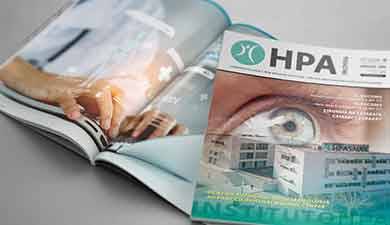Enf. Alain Delgado
Specialist Nurse
Maternal Health & Obstetrics

Communication during labor
Quality implications in obstetrics
HPA Magazine 18
Communication is one of the most important elements to achieving success in any field.
In general, worldwide, teams are efficient when they are able to draw up a plan with the object of achieving a goal and when they are able to keep all the elements working on same plan, adapting to unforeseen circumstances to reach the same goal. But to be able to do this, it is always essential that communication between all elements of the team is uniform and that correct information is transmitted.
The health sector is especially sensitive in this area, as the effectiveness of interventions are not the only indicators of success.
Communication must be effective among the multidisciplinary team of professionals, but also with the patient. Many of the problems in the health area do not have to do with the technical side of the care provided, but with the lack of communication that many patients complain about.
This lack of timely and effective communication is responsible for the lack of trust that can occur towards professional staff.

Maternal Health · Labour
The area of maternal health is even more complex, as the Obstetrician and the Specialist Nurse have to deal with the expectations of the couple, who have often developed an ideal personal plan with an ideal childbirth. However, the possibility of its actual execution must respect but at the same time evaluated at each step by the professionals. This requires that the entire course of labour must have a constant and personalized follow-up.
What barriers can be encountered?
Labour is an individual and unique event for each couple. Because each couple is also different, different types of expectations, convictions, knowledge and ideologies can be found.
Some patients have no information on childbirth. Cultural or linguistic barriers make the communication process difficult.
Often, there are unrealistic expectations or ideologies and unmanageable convictions.
Associated fears, such as the much talked about obstetric violence can lead pregnant woman and their companion to create a barrier and constant defences that in no way facilitates the work of those who provide care so that they can also do their best.
Many people want to be prepared and seek information on childbirth beforehand. Despite their good intentions, it is necessary that they obtain a comprehensive view of childbirth, which focuses not only on natural childbirth as the best choice, but also on the concern for maternal and foetal well-being throughout the process.
The couple's perception on the subject of obstetric violence is also very important, as their previous experiences or that of close friends can condition the type of relationship they will build with the professional who is assisting in the labour. Although the severity of some situations varies, evidently many incidents could have been avoided if there had been more communication between the providers and the patient.
The identification of obstetric violence with gender violence appears in 2010. The idea of obstetric violence emerges as “…a set of practices that degrade, oppress and intimidate women in their personal reproductive health, fundamentally during pregnancy, childbirth and the postpartum period (…), violation of human and reproductive rights (…) can be physical, psychological and symbolic (gestures and attitudes) under invisible structural domain…”
What are the main complaints of patients on the concept of non-respected childbirth?
Disrespectful childbirth arises from the idea that excessive and disrespectful unnecessary interventions are often carried out during childbirth, such as:
• Routine interventions, shaving, enema, monitoring;
• Delivery acceleration procedures; Artificial Rupture of the Amniotic Bag (ARAB), membrane detachments;
• Reduced mobility;
• Lack of privacy;
• Lack of sympathy from the Professionals;
• A cascade of mechanized interventions;
• Limiting analgesia;
• Instrumented deliveries not discussed;
• Kristeller's manoeuvre (applying pressure to the upper part of the uterus to facilitate the delivery of the baby);
• Episiotomy;
• Too many professionals present;
• Desire for breech deliveries;
• Caesarean sections for no apparent reason.
MEANS OF COMMUNICATION
In view of this complex problem, there are several instruments that can help professionals deal with the fears, insecurities and stress of those who go through labour.
In this context, it is possible to use various communication models, which aim to cultivate the relationship between patients and professionals to establish a relationship of trust.
PARTNERSHIP MODEL
The “Partnership Model” aims to involve patients in their particular condition, seeking consensus in the treatment proposed, for a better collaboration. Communication and discussion time with the patient is essential.
AIDET
Another model is the AIDET communication, which consists of being considerate and positive (Acknowledge), mentioning name, duties and skills (Introduce), assigning an adequate time window for the plan (Duration), ensuring that the patient has the correct information (Explanation) and showing appreciation for her cooperation (Thank you).
MODEL OF RESPECT-CULTURAL DIVERSITY
This is an approach at a social level, one must seek to understand the patient’s point of view, avoiding judgment and assessment (Rapport).
We must remember that the patient came for help and try to understand the reasoning behind her behaviour. Support the patient’s feelings verbally (Empathy).
We should ask or try to understand if there are any barriers as far as care is concerned.
Help the patient to overcome barriers. Involve the family if possible. Make sure you are there to help (Support).
Seek to establish an alliance and demonstrate flexibility in controlling the situation.
Negotiate roles with the patient, ensure that you will work together to solve problems (Partnership).
Ask if they understood what was explained. Speak to the patient to clarify doubts (Explanations).
Respect the culture and beliefs of the patient, realise that the patient can also have a stereotyped view of the professional.
Recognize personal limitations. We may not know the meaning of medical problems in other cultures.
Recognize our system, and when it does not suit a particular patient (Cultural Competence).
Spend the necessary time to establish a relationship of (Trust).
ESSENTIAL POINTS OF COMMUNICATION DURING LABOUR
The above models of communication can be useful to elaborate a care plan. In general, any communication must be adapted according to the information obtained on the couple in labour:
• Always ensure the quality of service and care provided.
• Understand personal and background characteristics and adapt language accordingly.
• Evaluate the patient’s type of expectations, identify barriers.
• “Spend time” explaining all procedures, and explain if there are advantages in alternative procedures versus the patients preconceived expectations.
• An informed consent must always be established, delivery is personal and individual and must be respected.
• Make a short/medium term plan, but set a time limit. Briefly explain emergency plan B).
• Avoid radical changes. Do not defraud the set plan.
• Allow the patient time to accept changes to the set plan.
• Demystify wrong preconceived concepts, inform the patient on the specialized maternity care and build trust.
• Show concern, avoid excessive evaluations, ensure privacy, every delivery is personal.
• Involve other professionals in the plan/trust relationship.
• Provide attention to the partner (motivator or negative influence)
• Subtly re-evaluate expectations (these can also readapt given time)
• An attempt should be made to establish a relationship of empathy/trust and ensure that the team's objective is the birth of a healthy child and to provide a positive experience for the couple.
One of the biggest problems is that it is not always possible to meet all patients’ expectations, there are many factors to be taken into account. One of the most important is to always ensure maternal and foetal well-being.
Effective communication is the best way to overcome barriers, create relationships of trust and ensure the collaboration of both the multidisciplinary teams and couple in labour.
The same care provided with and without effective communication is seen and evaluated by patients in a completely different perspective.
The better the patients’ understanding of the expected plan, the better a relationship of trust can be established and the higher the satisfaction rate.
Only personal communication can provide the intended outcome.








